Introduction: On 3 September 1939, shortly after the outbreak of World War II, the Allies cut the German cables from Emden to New York via the Azores and from Emden to Lisbon. In 1944 the American forces needed a secure connection from the USA to the Normandy beachhead, and Addison C. (Cal)
Sheckler relates here a previously undocumented story of how he and his crew accomplished the land operations of this important project to repurpose the Azores cable.
Cal was a Master Sergeant and technical expert on a US Army Signal Corps
team in Normandy following the D-Day invasion of France in June 1944.
M/Sgt Sheckler and his crew established the cable head and cable station
for the former German cable, which had been picked up by CS John W. Mackay and extended to Normandy. The
cable was used for direct and secure transatlantic communication by
the US Armed Forces in France for the duration of the war and after.
Editor’s Note: In December 2023 I received an email from Margaret Watkins, whose father Hubert Mott was one of the enlisted men at the cablehead. She provided details of his life and career as well as photographs of her father, including a variation of Cal Sheckler’s photo of the cable men, but with some of the subjects identified.
As Hubert’s story runs in parallel with Cal Sheckler’s account, I have inserted his text and photos in the appropriate locations below, identified by a red border.
See also Rudy Rudolph’s story of the cablehead after Cal Sheckler and Hubert Mott left in November 1945 along with the rest of the original RM crew. Daniel Crean, who Cal Sheckler mentions as taking on the position of civilian station chief when Cal went home to New York, was still at the cablehead when Rudy arrived in late 1945.
|
History
of the Transatlantic Cable Station "RM" in World War II
by
Addison C. Sheckler |
While it is difficult
to be precise, it would appear that the United States Army’s interest
in a transatlantic cable began in early 1942. This is evidenced by the
earliest date on some of the Western Union Company’s blueprints. It is
obvious from Western Union documents that a concerted and continuous effort
began at this time.
|

M/Sgt
Sheckler
School Photo, 1943 |
The Army Signal Corps
collected the necessary personnel during 1943 and at least in some of
the cases they were held on "Rations and Quarters" with little
or nothing to do. The author had been ill during the summer and the Army
sent him home for a ninety day "Recuperative Leave". The group
was assembled in New York in January and was assigned to study at the
Western Union Company’s Research Laboratory at corporate headquarters
at 60 Hudson St. The group consisted of eight enlisted men and two Second
Lieutenants.
The course work
was taught by Mr. W.F. Wilder and Mr. Dickey, both of Western Union’s
engineering department. The instruction started with Lord Kelvin’s definitive
treatise on telegraphy. All aspects of ocean cable telegraphy were taught,
from the simple devices like the siphon recorder to the most modern equipment
used on high speed multiplex cables. The work included operation and maintenance
of the various machines which we would use. We were also taught the protocol
necessary to set up and operate a modern cable station.
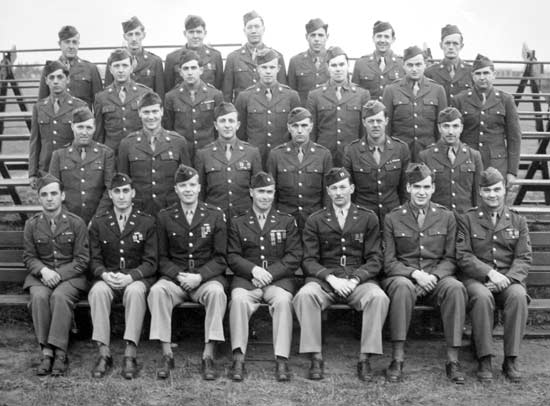
3104th Signal Service Battalion, Headquarters Company,
U.S.
Army Signal Corps photo
[Probably taken at Camp Edison,
Sea Girt, NJ sometime
in the spring of 1944. See also
Hubert Mott's
photo at the
end
of
this page, which was taken at Fort Monmouth, NJ in May 1944]
Digital image of the original courtesy of James G. Foradas, Ph,D.
Site visitor Dave Rothwell Sr. believes that his cousin
“Bud” French
is second from the right in the back row.
If you can provide names or any other information for any of the men
in
this photograph, please email Bill Burns: [email protected] |
This all ended, complete
with a graduation and diplomas at the end of April 1944. We still were
not needed so we marked time, but remained at Western Union. They managed
for us to spend time at the operating sites actually seeing the systems
work. We visited the terminal at Broad St (CD); we visited the cable terminus
at Rockaway Beach (Hammel HM). We visited Commercial Cable’s New York
offices and their terminal at Far Rockaway. We even spent time at RCA’s
telegraphic terminal in New York.
About June 4 we were told that we were
leaving immediately and on June 6, 1944 we were on board the Queen Mary
bound for Europe, but we still did not know anything about our organization.
The names of the people follow:
| Officers: |
|
| Second Lieutenant
Orville Williams |
Second Lieutenant
(Name Unknown) |
| |
|
| Enlisted
Personnel: |
|
| Addison C Sheckler |
Charles Chandler |
| Walter Herman |
Hubert Mott |
| Jerome Saffer |
Edward Walters |
| Isadore Gussow |
Name Unknown* |
| *This is believed to be Gino ("Rick") Riciardelli, according to a June 2018 story on him by Amy Hogan of WICZ-TV in Vestal, NY. |
We arrived in Cheltenham,
England and found that we were part of the 3104th Signal Service Battalion,
which was to supply communications for SHAEF (Supreme Headquarters Allied
Expeditionary Force) and for COM Z (Communication Zone).
Hubert Mott
After joining the Army early in 1944, Hubert Mott attended the Western Union School for work with the Signal Corps, with many of his fellow April 1944 classmates specializing as Submarine Cable Station Technicians. He was then assigned to Company C, 3104th Signal Service Battalion at Fort Monmouth, New Jersey, where his section was briefly present before leaving for England on 6 June 1944 aboard HMS Queen Mary. |
 |
The TO (Table
of Organization) said that we were two cable teams of one officer and
four enlisted men each. In actuality we were a single team and had ten
people because we had to operate a cable station twenty-four hours a day,
seven days a week. About the fifth of July we were moved to Southampton
and on the sixth we arrived on Omaha Beach. We were stationed at Valognes
along with COM Z.
|
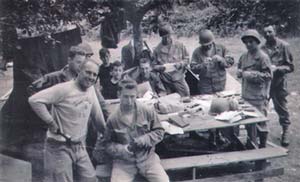
Marking
time at Valognes, July 1944 |
Hubert Mott
Upon arrival in Normandy on 21 July 1944 Mott and his unit worked on communications operations. One of their major accomplishments was the construction of a complete 16 kilowatt radioteletypewriter station and cross-Channel radio relay at Valognes for COMZ (Communication Zone) headquarters in only nine days at the start of August 1944. |
Again we waited
because the army had not yet broken out of Normandy. Meanwhile the transport
people were moving a truly immense amount of supplies and storing it in
many depots, which consisted of fields with very large piles of crates.
It is hard to describe the magnitude of these supplies. We marked time
helping out where we could but we were sleeping on the ground and for
three or four weeks ate K rations.
About mid-August
we started to look for our supplies, which consisted of 139 large wooden
crates randomly stored in the aforementioned depots. All of the crates
had a code marking on them and you found them by walking down aisles looking
at each crate. It took about five weeks and we found 138 crates. Fortunately
the 139th crate had paper supplies which could be found elsewhere.
|
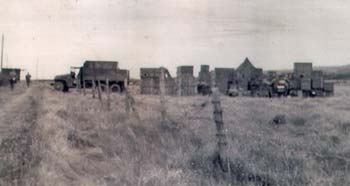
138
crates arriving, October 1944.
It took two months to find them. |
I should mention
that during this period the one officer (name unknown) had caused a great
deal of trouble. He then decided that he wanted to go to the front lines
so he could be part of the action. His request for transfer was honored
almost instantly and when he left the enlisted men (and some superior
officers) stood and waved goodbye. This left the team with one officer
and eight men.
|

Cable
head, Urville Hague, Normandy, Aug-Sep 1944 |
About mid September
the cable landing site was identified as the beach at Urville Hague, a
small town about eight miles west of Cherbourg. The lieutenant and the
author of this paper surveyed the site for suitability. The area was a
gigantic mine field and had to be cleared. An Army mine clearing company
came in and removed the following from the area that we would occupy:
35 Mustard Pots
- anti-personnel
51 Teller Mines - anti tanks - 10# TNT
100+ Bouncing Betties - Shrapnel anti-personnel
|

Teller
mine damage, Sep-Oct 1944 |
They missed two mines,
one of which blew up one of our trucks and badly injured the truck driver
who was evacuated to England and then to the United States. The other
mine that they missed, one of our fellows stepped on, but fortunately
it failed to detonate. Needless to say you could not go outside of the
limits of our site. Later many people were killed in this area.
|
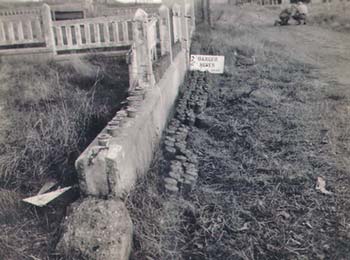
Bouncing
Betties, anti-personnel mines, Sep 1944 |
Our time was occupied
in moving our equipment, arranging for buildings to be built, obtaining
diesel generators, and two diesel mechanics etc. The English Army had
established a cable landing about one half-mile west of us on the same
beach and we began to cooperate with each other.
About this time
the army got around to ranking the various personnel. Lt. Williams was
promoted to 1st Lieutenant, Addison Sheckler and Walter Herman were master
sergeants, Jerome Saffer and one other (unknown, but probably Gino ("Rick") Riciardelli; see note above) were Technical sergeants
and the remaining four were staff sergeants.
|
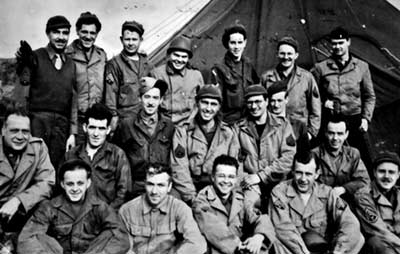
Our
crew plus the British neighbor cable crew, with
Lt. Col. Allen Wharton, War Department, 23 Oct 1944
See below Hubert Mott’s photo from the same session,
which identifies some of the subjects |

3104th Signal Service Battalion personnel at
Cable Station RM, Urville-Hague, France, October 1944
Ken Bowling, Ed[ward] Walters, Cal Sheckler, J[erome] Saffer,
W[alter] Herman, Orville Williams, Hubert Mott (HCM)
Photo from Hubert Mott, courtesy of Margaret Watkins |
On October 20, 1944
the cable ship John W Mackay arrived at Cherbourg and Lt. Williams and
Sergeants Sheckler and Herman went aboard to discuss the cable landing.
The cable was the loaded cable 1 HO from New York to Horta, Azores, and
then on to Emden, Germany. The cable had been cut in the English Channel
at the beginning of the war and the intent was to pick this up and bring
it to shore for our use. The cable was landed on October 23 and the splicing
at sea was completed on October 27. We established communications with
Horta, Azores, by key and siphon recorder.
|
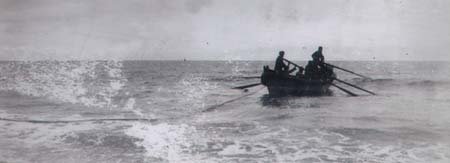
Here
comes the line! |
|
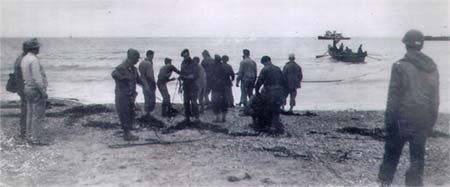
Hauling
in first line |
|

Hauling
in the shore end |
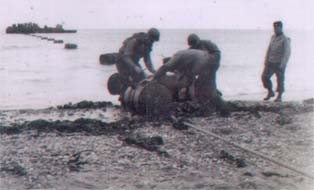
The
shore end landed |
|
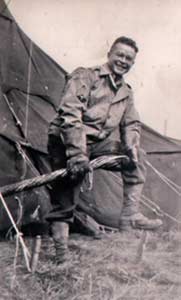
S/Sgt
Isadore Gussow,
23 Oct 1944 |

British
cable technician finishing off the cable head |
Hubert Mott
Their crowning achievement, however, was the landing of the transatlantic cable head, designated "RM," seven miles west of Cherbourg on 23 October 1944. Following a month of work, the communications system was placed into operation on 5 December 1944. |
The operations building
was an army pre-Fab and was complete enough for us to go ahead by November
5. The author was the only person on the team with engineering experience,
and Lt. Williams and he were the only ones with electrical experience.
Lt. Williams had been a telephone installer for Illinois Bell. Western
Union’s training had been excellent and each person was given his assignment
for installation and wiring and in one week the station was complete.
However no planning had been done for the power wiring other than to supply
the three Hill diesel generators. These were installed at the same time
as the other work but there was no transformers or power cable available.
We found the transformers someplace and installed them. The British Cable
Station down the beach from us had salvaged about 1,000 feet of heavy
power cable from a German command center also on the beach. We "liberated"
that cable and completed the station. For a short while there were hard
feelings between us and the British soldiers but we all got over it.
|
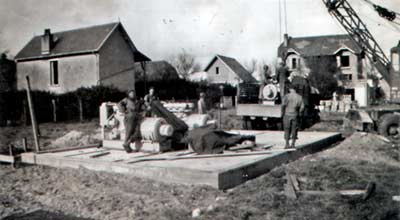
Installing
three Hill diesel generators, about 1 Nov 1944 |
|

Station
taking shape, early Nov 1944 |
|
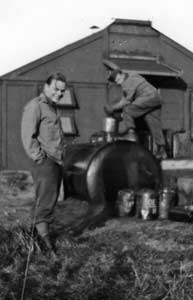
|

|
Fueling
up. M/Sgt Sheckler and
diesel mechanic, early Nov 1944 |
Now came the hard
part of getting the station working! We had been trained well but something
had not been taken into consideration. The Horta - Emden cable was special
in that it was inductively loaded. There was no loaded cable available
to splice on and bring ashore so they used a fourteen-mile piece of unloaded
cable. This unfortunately created an impedance mis-match at the splice
and the middle frequencies of the cable signal were reflected back. This
in turn effectively created a hole in the cable’s frequency band-pass
response. We had been trained in cable signal correction but this only
applied to linear corrections. The author was the only one who truly realized
what the problem was and consequently was the one who had to solve it.
We got the system up and sort of operating by November 30, but the error
rate was intolerable. It took two more weeks to find a compromise solution
to the problem but finally on December 13 we were successful. We had lowered
the error rate to about 1 in 10,000 and while we could still see this
the user could not and the station continued at this rate from that time
on. At this time the station was handling military traffic on A and E
channels. C channel was reserved for cable management. Later D channel
was extended to Cable & Wireless in London and B channel was devoted
to the British Foreign Offices Delegation at the organization of the United
Nations. The cable had a capacity of about 350,000 five-letter groups
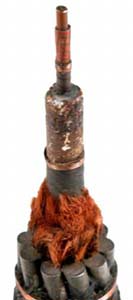
1926 Azores-Emden cable. The inductive loading tape surrounds the conductor. |
A description of
the equipment is in order. Western Union had three special (i.e. loaded)
cables 1 HO (Horta), 4 PZ (Penzance), and 2 HO. I HO was linearly loaded
and operated at 32.5 Hertz. 4Pz was linearly loaded but shorter and operated
at 55 Hertz. 2 Horta was taper loaded and operated duplex at 30 Hertz.
It should be noted that modern cables all operate with single fill-in
i.e. the data rate is twice the bandpass frequency. For more information
the reader is referred to Lord Kelvin’s treatise on Telegraphy.
These special cables
all had special terminal equipment, which was built for the cable when
it was installed. There was very little extra equipment and in our case
there was one duplicate distributor and one duplicate tuning fork (clock)
in New York and these were the units which we used. This left no spares
anywhere. There were no spare amplifiers and the ones in use had been
built by Western Electric in the 1920’s. Consequently Western Union refurbished
the duplicate equipment and designed and built new power supplies and
a new amplifier (which became their new standard). The station consisted
of a 561A amplifier (with cable shaping) and power supplies. This fed
into a five-channel distributor, which was capable of reversing direction
automatically. The distributor was driven by a temperature compensated
tuning fork identical to those in Horta and New York. The time standard
was set by New York; every five letters a time signal was sent and
Horta and our station corrected our time to be correct with New York.
The signal left the distributor or arrived at the distributor through
peripheral signal processing equipment. Signals coming from New York went
to five tape perforators which also printed on the tape. This tape then
went to a tape reader, which sent the signal out on land lines. Incoming
land line signals (which were in Baudot code) went to an electrical/mechanical
translator which converted the Baudot code to cable code which then went
to the distributor and out to New York.

Western Union cable system in North Atlantic,
showing the route of the Azores-Emden cable. |
The station’s code
designation of RM came about in an interesting manner. When we were having
trouble shaping the amplifier we were being sent signals from Horta (HO)
and lots of communications. They addressed us as ARMY. The error rate
was so high that this often came out RM so we adopted that call.
Maintenance procedures
were set up and by the end of December 1944 the station operated without
any difficulty from that time on.
A tape relay station,
JEAC, was appended to the facility and additional personnel were brought
in to operate it. This and subsequent land line operations are covered
in Lt. Williams’ report (appended). The overall manpower eventually rose
to about thirty military personnel, about twenty French civilians, and
forty German prisoners. Interestingly the German prisoners were not guarded
and we had no fence but we had no trouble of any kind. Apparently this
was a safer, more comfortable place than any other they could imagine.
They supplied the facility labor and they made the place into a very good
looking military camp. The author had many conversations with individual
Germans and none of those with whom he spoke wanted to go back to Germany
until the war was over.
Lt. Williams eventually
got bored since there was very little to do and he asked for a transfer.
After him we had a progression of officers who had no knowledge of the
facility and who spent their time making the camp more elaborate. Some
of this is shown in the appended photos.
Unfortunately the
original crew were witnesses to the sinking of a troop ship December 24(?)
just off Cherbourg Harbour. A very large number of people died, perhaps
as many as 1,000.
|

Cable
Station RM, Summer 1945 |
The station operated
with no trouble from that time on. After VE Day (8 May 1945) the 3104th
Signal Service Battalion was sent to the Pacific, but we were left behind
because the station continued. The battalion was on board ship entering
the Suez Canal on VJ Day and they received orders to turn around and go
to New York. They were some of the first people discharged after the war.
We continued on and the army in November 1945 asked the author to stay
on as civilian station chief at an amazingly high salary. The author refused
the position and another man, Daniel Crean, was recruited for the position.
Crean arrived about November 15 and had about two weeks to get acquainted
with the station.
Hubert Mott
While a majority of the unit was designated for service in the Pacific following the German surrender, the men operating RM remained on station in France through at least November of 1945. Mott and the others seem to have returned to the States in December of 1945, with his local paper, the Syracuse Herald-Journal, announcing his honorable discharge from the Fort Dix separation center on 12 January 1946. |
A final anecdote
is in order. Mr. HF Wilder of Western Union, Mr. Breyfogle of London office
Cable & Wireless, and Lt. Col. Allen Wharton of War Department all
were present at the landing of the cable. Mr. Wilder took home a detonator
from a Bouncing Betty mine - a spring snap action device - and when he
got home he got in the habit of snapping this device while reading at
his desk. Suddenly after thousands of snaps the percussion cap exploded
and blew a small hole in his desk top. Fortunately no one was hurt but
he had a permanent memento of the cable station.
|
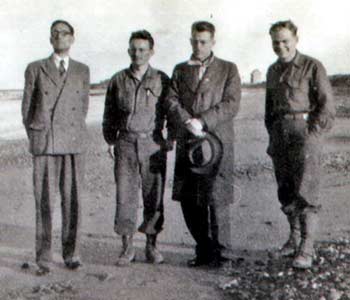
L to
R: Mr. Breyfogle, M/Sgt Herman,
Mr. Wilder, M/Sgt Sheckler, 23 Oct 1944 |
During 1945 and
1946 Western Union brought together all of the technical documentation
and built new equipment to replace that which we used. The author used
this documentation for his senior thesis at Drexel University. The documentation
still exists.
Technical
history of transatlantic cable head by
Orville H. Williams, 1st Lt. Sig C.
The cable was landed
at Urville-Hague about seven miles west of Cherbourg on the morning of
October 23, 1944. The landing was made from a harbor barge under the direction
of the crew of the cable ship John W. Mackay and Lt. Col. Allen Wharton
of War Department. After the shore end of the cable was landed the cable
ship left to complete the off-shore splices.
On October 27th the
splicing was completed and contact was made with Horta, Azores by siphon
recorder and cable key.
 |
 |
Sample
of cable used to connect the original German line
to the new cable station in Normandy. As this cable was
not loaded, the impedance mismatch to the existing cable
caused the difficulties in shaping which Cal describes above.
Cable sample courtesy of Cal Sheckler
Photos by Bill Burns, August 2004 |
The operations building
was sufficiently completed on November 5th to start the installation of
equipment and by November 12th the equipment was installed and wired.
The rest of the installation was spent in adjustment of equipment and
shaping of the amplifier. The adjustments of all the equipment was completed
on November 25th; however the amplifier was not yet shaped.
The amplifier shaping
started on November 14th and due to an irregularity in the cable characteristics
was not finished until November 30th.
On November 30th
the final tests were made with Horta, and at 2130 the circuit was extended
to CD in New York. Due to some engineering discrepancies the next few
days were spent aligning the circuit between New York and Urville-Hague.
On December 4th the circuit was connected through to JEJE and JEAR on
A and E cable channels respectively. After a day’s tests the circuit was
put up for traffic and traffic began between WAR and JEJE and WAR and
JEAR on December 5th.
In the period from
December 5th through January 4th 1945, operations were normal with two
exceptions. One of the troubles experienced was with the amplifier shape,
however this was cleared completely on December 13th. The other trouble
in this period was with landlines and this persisted until about February,
when the wire conditions were much improved.
On January 4th a
temporary installation of the tape relay station JEAC was completed after
about two days work. This installation consisted of typing reperforators
and transmitter-distributors terminating the land lines and the same type
of equipment terminating the cable channels. This station, along with
WFQ at New York, allowed full usage of the cable channels and also served
to absorb the time lag between the cable and the landlines.
An alternate traffic
route, terminating at JEAC and JETA, was installed on January 8th.
Work was being done
on a permanent installation of JEAC during this period and on February
2nd the work was completed, and JEAC went into permanent operation.
Another alternate
traffic route was installed on February 28th, terminating in JEAC and
JEVL.
On March 6th, a new
circuit was put into operation on the cable between Cable and Wireless
London and Cable and Wireless Fayal, Azores on the D cable channel.
On March 8th the
alternate route between JEAC and JETA was discontinued.
On March 15th a circuit
between JBJB and JEAC was installed for the purpose of giving JBJB an
alternate route to WAR.
After several tests
a circuit was started up between the British Foreign Office in London
and the British delegation at the San Francisco conference. The circuit
was put through the "B" cable channel for traffic on April 19th,
and continued in service until June 2, 1945.
The full capabilities
at this cable have never been utilized and are approximately as follows;
70,000 groups total for one channel in a twenty four hour period and 350,000
groups total for all five channels in a twenty four hour period.
Orville
H. Williams,
1st Lt. Sig C.
Text and images copyright
© 2004 Addison C Sheckler. Used by permission.
Hubert Mott text and images courtesy of Margaret Watkins, December 2023
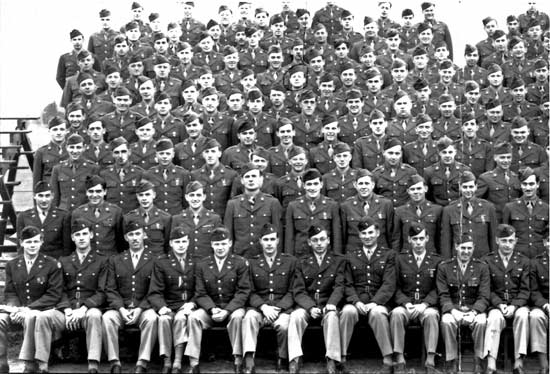
Company C, 3104th Signal Service Battalion
May 1944, Fort Monmouth, New Jersey
Hubert Mott is in the seventh row center, circled
Photo from Hubert Mott, courtesy of Margaret Watkins
If you can provide names or any other information for any of the men
in
this photograph, please email Bill Burns: [email protected] |
Editor’s
Notes: The German cable diverted to Normandy in 1944 was the Azores
- Emden connection to Western Union’s Azores - Newfoundland cable of 1926.
This 1926 cable, identical in construction to the 1924
cable, was linearly loaded.
According to an article in Underseas Cable World, Vol 1, No. 10, April-May 1968, the 1926 cable was once again diverted in 1960, when it was restored to its original path. The German Atlantic Telegraph Company relocated, re-connected, and re-established operation of this cable, which then once again carried telegraph signals from Borkum to Horta, Azores.
For a technical description of the 1928 cable on this same route, which
used taper loading and was the first high-speed duplex long distance cable,
see the 1931 article: The
Newfoundland-Azores High-Speed Duplex Cable.
Postscript: An article in the New York Times, Sunday March 31 1957, is evidence that Cal Sheckler’s painstaking work paid off.
War Prize Put to Work
When the Allies invaded France in 1944, the Army Signal Corps dredged up the cut end of the Emden-Azores cable from the English Channel and led it ashore at Cherbourg, where it was tied in with a military trans-Atlantic telephone and teletype network. It still operates. |
Note, however, that the cable was not used for trans-Atlantic telephone calls in 1944, nor subsequently; this capability was not available in trans-Atlantic cables until TAT-1 in 1956.
Don Morton adds this further note on the later history of station RM:
I was stationed at RM from mid 1951 through December 1952. I was employed as an engineer at Motorola Government Electronics Division in Phoenix, Arizona, when I was drafted in Jan 1951. I had my First Class FCC Phone license and had worked my way through college working in broadcast stations. I had my amateur radio license (W7LBN) which I still have, as well as my degree from Arizona State.
I was sent to basic training for 14 weeks of infantry training and then to Ft. Monmouth New Jersey for assignment in the Signal Corps. I remember the interviewer saying, "You have a ham license so you can copy code?" to which I agreed. His next question was "How would you like to go to France?". I know I happily replied yes, as the alternative was probably Korea and combat areas.
A number of us were sent to school at Western Union’s offices at 60 Hudson Street in New York City for several weeks, then to Rockaway Beach to work on the U.S. end of the cable with Western Union technicians. Then we were sent to France. I think there were six of us—two of us were draftee engineers; another had been working for RCA and I knew him from college and ham radio contacts.
When we arrived at RM, or Cherbourg, the cable had just been cut at sea and the techs on hand were trying to make measurements and determine how far out the cut/break was located. When everyone else went to eat the other engineer and I took a look at the test equipment, made some measurements, calculated a bit and figured out about where the break was located. When the regular personnel came back from eating we gave them our data, they contacted the cable repair ship and they proceed to locate it, pick it up and repair it. Instead of using Morse code to communicate with the ship we used GI field telephones since the break was only 8 or 10 miles off shore.
For routine operation we also put code oscillators in parallel with the telegraph clackers because we were much better at reading Morse from tones than clackers. We later had a break off the Azores that took a while to fix as the cable ship reported it was probably 21,000 feet deep at that point.
We understood at the time that the U.S. had no cable ships and the British did the work at sea for us.
When I was there we were part of 7774 Signal Battalion, headquartered in Germany. Our on-site commanding officer was Maj. Allison D. Melvin, now retired and living in Sierra Vista, Arizona, the last I knew.
I arrived there as a private and left as a Staff Sergeant and went back to work as an Engineer at Motorola, and as a civilian. I learned something about multiplex, saw a lot of equipment that seemed like it should be in a museum but it got the job done and we kept it working. |




























